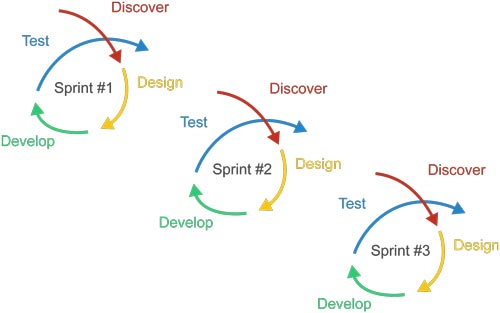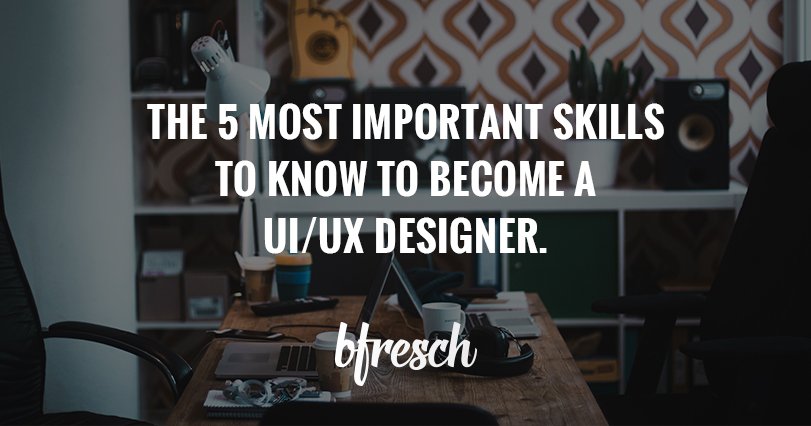To begin let’s start by answering these questions, what’s UI Design and what’s UX Design? How are they different?
“UI” stands for “User Interface“. So that means the buttons, text, pixels, and layouts etc. appearing on computer screens is your design work. That, however, is the easy part what is challenging about being a UI Designer is to keep real users in mind when designing elements in your interface. So, how do you do this? Well, I think this is where a UX Designer comes in. In my opinion, it isn’t possible to have one without the other, that is why you see the job title looking like this: “UX/UI Designer”.
“UX” stands for “User Experience“. UX Designers emotionally connect a user to a brand/product. UX designers intentionally create the best experience through research and communication. Without user awareness, companies don’t succeed, it’s as simple as that.
“UI” and “UX” Design differ in execution, “UI” is focused on actual execution of design and “UX” is focused on informing the decisions that are being made in “UI” design. They’re the same in that they are both very aware of the user and strive to better understand those people every day.
These skills are in my opinion in succession of importance.
 Most Importantly, Know If You’re Willing to Talk With People.
Most Importantly, Know If You’re Willing to Talk With People.
Let’s get down to brass tacks, you can’t be uncomfortable talking with people as a UX/UI Designer. If it makes you uncomfortable you better love the work more than being an introvert. You have to physically get out of the office and commit to communicating to the right people face to face. Spend a day in their shoes, know if you’re designing for the right person, don’t assume aka, “guess” you know anything. If there is one singular thing I have learned, it’s that I can’t assume anything about anyone, ever.
At my company, we’re building management software for feed yards. I am the UX/UI Designer responsible for this software’s interface. I have built personas around who I think these feed yard managers are and I am from the midwest I should have a pretty good idea who these people are, right? NO! Personas, are unreliable they and need to be thrown out of your workflow. Seriously, get rid of your personas and go talk with real people. I have learned way more about solving real design problems on horseback shadowing cowboys for a full day than I ever have/will for a fake cowboy persona at the office. It’s made up of assumptions, not real feedback, it’s unreliable information.
 Drop Your Designer Ego.
Drop Your Designer Ego.
This is the second most important thing to know being a UX/UI Designer. I admittedly had to go through years of critiques and failed design work to learn that what I thought was groundbreakingly beautiful, wasn’t and what I thought would make a paradigm shift in all things design, didn’t. After so many critiques and multiple crumpled paper three-pointer shots into the trash can, I became obsessed with this one question, how do I know what good design is? Here is the statement all designers have to hear.
“Beautiful design isn’t always the best design.”
The prime example…craigslist.
It hurt when I realized design doesn’t have to be beautiful to be a good design. When you’re first honing in on your design skills as a young designer you get attached to the work people like. Well, the work people like in design school is highly artistic and it follows the rules of design. However, in the real world, you’re not designing for yourself, a grade, or a professor knowledgeable in good design practices. No, you’re designing for people who don’t know anything about that or often care. With the title of designer, you need to understand this means you’re not an artist. Nobody cares about beautiful unless it helps them achieve something they are looking to do more easily. After multiple attempts to disprove this and failing, I decided that this was actually exciting news. I was no longer competing with other designers for a better grade, I was competing with my companies competitors for better experiences, something measurable not subjective. I learned this is the calling of a true designer. Designers solve problems and make experiences easier, that in my opinion felt more important than making something as beautiful as possible.
“Designers solve problems, Artists create questions.”
If you’re a student getting ready to graduate from a “design/art” college, know that you will have to make this decision. Are you an artist or are you a designer?
 Learn to Stand Behind Every Design Decision You Make.
Learn to Stand Behind Every Design Decision You Make.
Learn to stand behind every element within your UI design. If you can’t you probably don’t know your users enough or you are not designing with your users in mind. This is not an easy thing to do under a timeline breathing down your neck. It takes practice, I myself am getting better at this on a daily basis. I have found that collaboration with other people is extremely important in catching elements you were not 100% focused on the user.
Don’t defend the elements that weren’t designed for the user. Again, drop your designer ego, you have to accept that what you think you know is most likely wrong. If you need to gain more information the best resource are the users themselves. Get out of the office and go talk with them if you can. If you can’t talk face to face with them, ask them if they can review this element and write a review on it when they have time. People like to share their opinions, it feels like somebody cares about their opinion which only strengthens the relationship they have with your company.
If you’re worried about coming off as an annoyance don’t be, you’re not a salesman demanding attention for something they don’t want. You’re a designer who is designing something they do want. It is your job to genuinely care and understand why they want it and why their life is worse without it. Your job as a UX/UI Designer is to protect the trust users have in your company to deliver the best experiences possible for them. This is only achieved by user awareness, communication, and collaboration.
 Know How to Measure Data and Pivot Your Design.
Know How to Measure Data and Pivot Your Design.
UX/UI design is a continuous relationship with your companies users. Like any relationship, it can transform and improve with time and knowledge. As UX/UI Designers, our job is to massage this relationship by learning what is better. Luckily for us, this is more measurable than ever before.
“Data is the greatest asset in a UX Designer’s toolbox.”
There are multiple ways to gain data of your design work.
When it comes to mass data, here is a list of tools to consider using in your workflow. Be careful what you choose to work with as I believe there are very few that can actually help in providing accurate data on a timeline.
Usertesting.com is a paid solution that allows you to target people that fall into the qualifications of being an actual user. It’s not as good as talking with actual users but it’s better than personas because it’s an actual person who could potentially be a customer. If you are UX/UI Designer building a website it’s particularly nice because you can watch and listen to how they verbalize their thought process and move through a realistic scenario. When you set up this test you ask a set of questions most likely tying in the goal your company wants to achieve on this website. This tool, in my opinion, is still not ideal because you can alter the questions to better achieve or not achieve a goal in the scenario you’re creating. It isn’t an accurate measure of what a real experience looks like.
It would be more accurate if you could know the goal of an actual user when they come to the website then observe if they can achieve their goal or not.
Optimizely was extremely difficult for me to use and had a huge learning curve. The learning curve is so great in fact that they have an educational website devoted to showing their users how to implement their software. This, in my opinion, was asking too much of me. I wanted to have accurate data informing my design decisions and I wanted to do so on a timeline. Optimizely can give accurate data which is fantastic but you have to wait for some websites a month to three months to gain statistical significance. You also have to learn how to set up clicks goals properly which isn’t a simple thing to do because there are always bugs to work around within Optimizely. God forbid, you set it up wrong and find out a month into your test and when you try to change it you loose all data. I have done that more than once, not fun especially when it was because of an Optimizely bug.
This worked the best by far and people actually interacted with these surveys. My only issue with this is the lack of human connection this approach has. I want to build that strong relationship with the users my company is communicating to and while you may be asking the right questions and your intentions are good, people can’t feel your genuine interest and care for them. It separates that connection more than I prefer. I also understand that data is important and so is time, however, a handful of answers to 5 questions can only give insight on so much. I also understand that it can be more than difficult to personally talk with every user for some companies. However, that doesn’t mean that we shouldn’t try. 🙂
Here is a resource I haven’t used yet, I am really excited to try Heap Analytics in my future workflow. Heap Analytics automatically tracks every user interaction and the learning curve isn’t nearly as steep or problematic as Optimizely. Seems like this tool is going to rock my world and I can’t wait to use it!
 Have an Established but Flexible Workflow.
Have an Established but Flexible Workflow.
CAUTION: This is not an entry-level design position. Without graphic design or digital design experience, you can’t understand the level of effort this position is going to require from you. You really need to understand specific software programs like the back of your hand and you need to understand how to critique yourself for the betterment of your users on an individual basis and in a collaborative setting.
You must have experience working under strict timelines and go through the experience of being up all night learning that it takes a long time to render high-quality print documents. You have to be critiqued to the point you’re literally getting emotional and come to the realization it’s absolutely absurd to be emotional about your design work. This position has a requirement of earned scars from the design industry because without experience it takes too long to make the right judgment calls or design decisions.
If you’re new to the industry this isn’t a slam, if it feels that way, you lack patience. I am not telling you that you can’t be a UX/UI Designer. I’m saying give yourself a couple of years to go through the grind first and really embrace it because it helps teach you good design and gives you a deeper appreciation for good designers.
Establish a workflow that is effective, time efficient, and flexible. Don’t ever get stuck in your well-established routine of design. I recently have adjusted my traditional design waterfall workflow to a more agile design process with my team. It took me a little while to understand that I couldn’t plan for the unknown with a product that is completely new. My workflow has changed to reflect a more collaborative, iterative, and data-driven design process. Meaning, I start by defining the most important thing to focus on now and together with my team we collaborate on feedback and then I iterate the changes that need to be made and lastly, I measure the results. From my results my workflow kind of recycles itself by pivoting the design to reflect the data and make the design better. A lot of times when I do receive the data it creates more questions which in turn help me to define what the next most important thing I need to focus on next.
 Now Go Become a User-Focused Designer.
Now Go Become a User-Focused Designer.
Experience makes everything better!
• Know If You’re Willing to Talk With People.
• Drop Your Designer Ego.
• Stand Behind Your Design Decisions.
• Know How to Measure Data and Pivot Your Design.
• Have a Flexible but Established Workflow.
The world is a better place when we put people with emotions at the center of design decisions. We gain a better understanding of people and achieve greater in design and as people being connected in today’s world. There is no better time than to be a designer right now, with data software today we are learning so much about how our work is affecting people.

